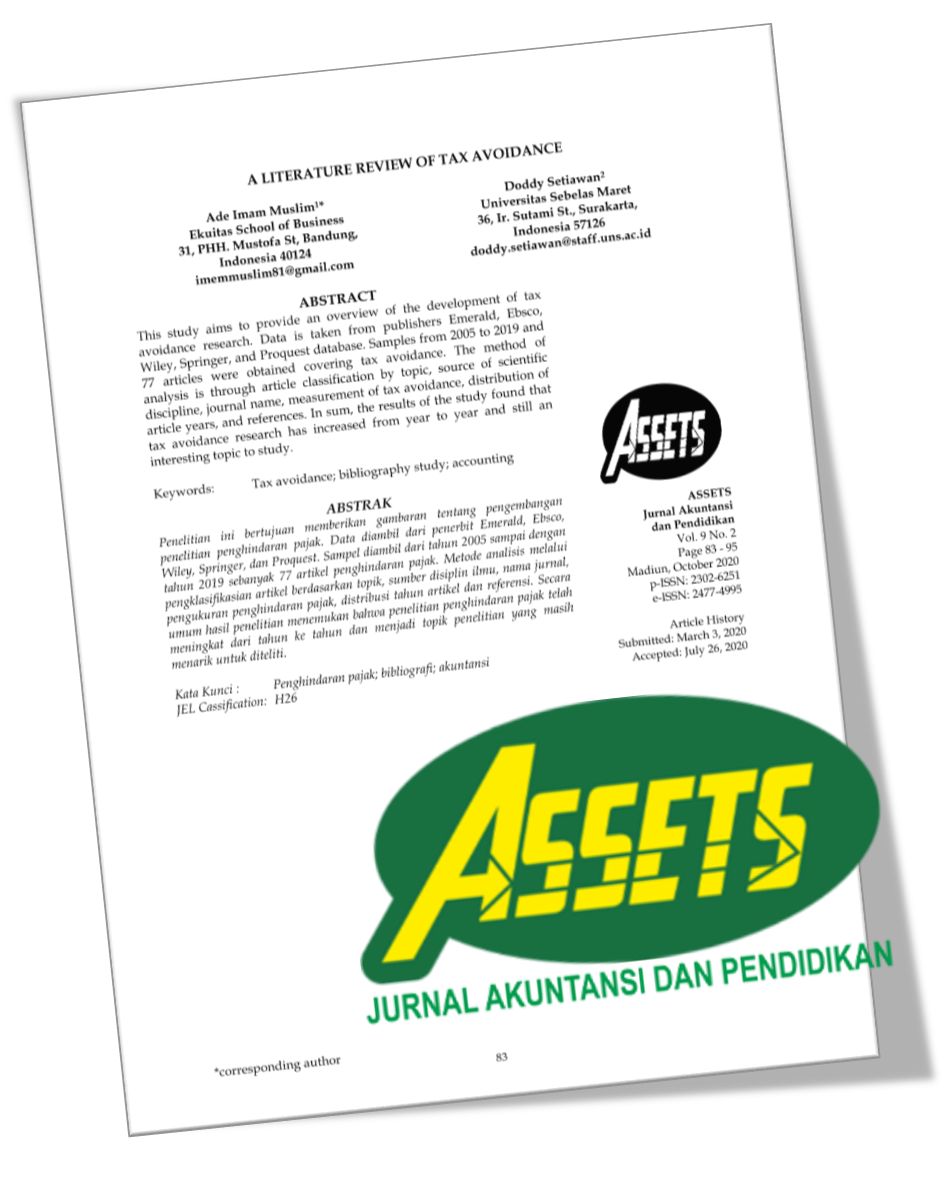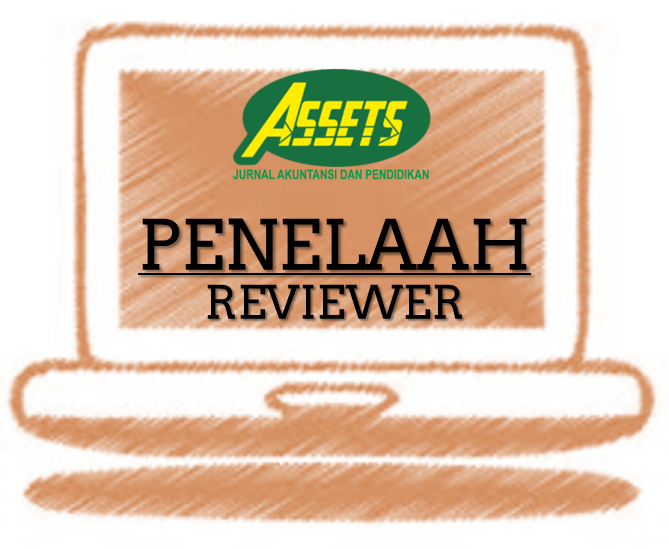VOLATILITY ANALYSIS USING THE EGARCH METHOD: CASE STUDY OF BBCA, BMRI, BRIS
Abstract
ABSTRACT
This study aimed to test the volatility model of BBCA and BMRI stocks on the IDX. The research problem is whether there is an influence of BBCA and LQ45 volatility on BMRI and vice versa. The study also tested whether BRIS's volatility was influenced by its majority shareholder, BMRI. The EGARCH model analyzed daily return data for 2015-2022 in bearish/bullish markets. The results showed that the data experienced heteroscedasticity problems, and the EGARCH Student's model was selected. The volatility of BBCA and BMRI returns does not affect each other but is influenced by LQ45 when bearish/bullish. The volatility of BRIS returns is influenced by BMRI only when it is bearish and the LQ45 index when bullish. The implications of the research prove the independence of stock investors (BMRI and BBCA) in making decisions. However, it was indicated that both investors were influenced by the decisions of most investors, which was reflected in the significance of the LQ45 index.
ABSTRAK
Tujuan penelitian ini adalah untuk menguji model volatilitas saham BBCA dan BMRI di BEI. Permasalahan penelitiannya adalah apakah terdapat pengaruh volatilitas return saham BBCA dan LQ45 terhadap BMRI dan sebaliknya. Penelitian tersebut juga menguji apakah volatilitas BRIS dipengaruhi oleh return saham pemegang saham mayoritasnya, BMRI. Model EGARCH digunakan untuk menganalisis data return harian tahun 2015-2022 saat pasar bearish/bullish. Hasil penelitian menunjukkan bahwa data mengalami masalah heteroskedastisitas dan model EGARCH Student's-t yang dipilih. Volatilitas return BBCA dan BMRI tidak saling mempengaruhi, namun dipengaruhi oleh LQ45 saat bearish/bullish. Volatilitas imbal hasil BRIS hanya dipengaruhi oleh BMRI saat bearish dan indeks LQ45 saat bullish. Implikasi penelitian membuktikan independensi investor saham (BMRI dan BBCA) dalam mengambil keputusan. Namun kedua investor tersebut terindikasi dipengaruhi keputusan mayoritas investor yang tercermin signifikansinya indeks LQ45.
Keywords
Full Text:
PDFReferences
Altintig, Z. A., Arin, K. P., Feess, E., & Schumacher, C. (2009). You are One of us Now! How do Share Prices of Rivals React to Privatization? Journal of Industrial Economics, 57(2), 265–293. https://doi.org/10.1111/j.1467-6451.2009.00375.x
Asgharian, H., & Liu, L. (2022). Product Market Competition and Stock Return Dependence. Finance Research Letters, 50, 103207. https://doi.org/10.1016/j.frl.2022.103207
Baele, L. (2005). Volatility Spillover Effects in European Equity Markets. Journal of Financial and Quantitative Analysis, 40(2), 373–401. https://doi.org/10.1017/s0022109000002350
Banerjee, P. K., & Kumar, A. B. (2009). Dynamic Effects of Changes in Interest Rates and Exchange Rates on the Stock Market Return in Bangladesh. Ritsumeikan Journal of Asia Pacific Studies, 3(1), 459–464.
Będowska-Sójka, B., & Kliber, A. (2019). The Causality between Liquidity and Volatility in the Polish Stock Market. Finance Research Letters, 30, 110–115. https://doi.org/10.1016/j.frl.2019.04.008
Blau, B. M. (2018). Exchange Rate Volatility and the Stability of Stock Prices. International Review of Economics and Finance, pp. 58, 299–311. https://doi.org/10.1016/j.iref.2018.04.002
Bollerslev, T. (1986). Generalized Autoregressive Conditional Heteroskedasticity. Journal of Econometrics, 31, 307–327. https://doi.org/10.1109/TNN.2007.902962
Box, G. (2013). Box and Jenkins: Time Series Analysis, Forecasting and Control. A Very British Affair, October 1919, pp. 161–215. https://doi.org/10.1057/9781137291264_6
Campasano, J. (2021). Portfolio Strategies for Volatility Investing. Journal of Alternative Investments, 24(1), 43–60. https://doi.org/10.3905/JAI.2021.1.130
Cheriyan, N. K., & Lazar, D. (2019). Relationship between Liquidity, Volatility and Trading Activity: An Intraday Analysis of Indian Stock Market Supply Chain Management View project International Journal of Economics and Financial Issues Relationship between Liquidity, Volatility and Tradin. International Journal of Economics and Financial Issues, 9(1), 17–22. http:www.econjournals.comDOI:https://doi.org/10.32479/ijefi.7268
Chon, S., & Kim, J. (2021). Does the Financial Leverage Effect Depend on Volatility Regimes? Finance Research Letters, 39, 101600. https://doi.org/10.1016/j.frl.2020.101600
De Silva, T. (2017). The Importance of Profitability in Determining Volatility Across Industries with Different Debt Levels. Undergraduate Economic Review, 13(1).
Dornbusch, R., Chul, Y., & Stijn, P. (2000). Contagion : How Understanding It Spreads. The World Bank Research Observer, 15(2), 177–197.
Eldomiaty, T., Saeed, Y., Hammam, R., & AboulSoud, S. (2020). The Associations between Stock Prices, Inflation Rates, Interest Rates are still Persistent: Empirical Evidence from Stock Duration Model. Journal of Economics, Finance and Administrative Science, 25(49), 149–161. https://doi.org/10.1108/JEFAS-10-2018-0105
Engle, R. F. (1982). Autoregressive Conditional Heteroscedasticity with Estimates of the Variance of United Kingdom Inflation. Econometrica, 50(4), 987–1008.
Ezzat, H. (2012). The Application of GARCH and EGARCH in Modeling the Volatility of Daily Stock Returns During Massive Shocks: The Empirical Case of Egypt. International Research Journal of Finance and Economics, p. 96.
Farbmacher, H., & Kögel, H. (2017). Testing Under a Special form of heteroscedasticity. Applied Economics Letters, 24(4), 264–268. https://doi.org/10.1080/13504851.2016.1181827
Franses, P. H., & McAleer, M. (2002). Financial Volatility: An Introduction. Journal of Applied Econometrics, 17(5), 419–424. https://doi.org/10.1002/jae.693
González-Hermosillo, B., Martin, V., Fry, R., & Dungey, M. (2003). Unanticipated Shocks and Systemic Influences: The Impact of Contagion in Global Equity Markets in 1998. In IMF Working Papers (Vol. 03, Issue 84). https://doi.org/10.5089/9781451850666.001
Gujarati, D. N., & Porter, D. C. (2009). Basic Econometrics. The McGraw-Hill Series Economics. 5th Edition. New York.
Hudson, R. S., & Gregoriou, A. (2015). Calculating and Comparing Security Returns is Harder than You Think: A Comparison between Logarithmic and Simple Returns. International Review of Financial Analysis, 38(0), 151–162. https://doi.org/10.1016/j.irfa.2014.10.008
Kennedy, K., & Nourizad, F. (2016). Exchange Rate Volatility and its Effect on Stock Market Volatility. International Journal of Human Capital in Urban Management, 1(11), 37–46. https://doi.org/10.7508/ijhcum.2016.01.005
Kim, K., & Song, J. W. (2020). Analyses on Volatility Clustering in Financial Time-Series Using Clustering Indices, Asymmetry, and Visibility Graph. IEEE Access, 8, 208779–208795. https://doi.org/10.1109/ACCESS.2020.3037240
Kumar, J. J. A., & Robiyanto, R. (2021). The Impact of Gold Price and US Dollar Index: The Volatile Case of Shanghai Stock Exchange and Bombay Stock Exchange During the Crisis of Covid-19. Jurnal Keuangan Dan Perbankan, 25(3), 508–531. https://doi.org/10.26905/jkdp.v25i3.5142
Lauridsena, J., & Kosfeld, R. (2011). Spurious Spatial Regression and Heteroscedasticity. Journal of Spatial Science, 56(1), 59–72. https://doi.org/10.1080/14498596.2011.567411
Li, J., & Luo, Z. (2020). The Impact of Product Market Competition on Stock Price Crash Risk. Journal of Business and Industrial Marketing, 35(7), 1141–1153. https://doi.org/10.1108/JBIM-12-2018-0375
MacKinnon, J. G. (1996). Numerical Distribution Functions for Unit Root and Cointegration Tests. Journal of Applied Econometrics, 11(April), pp. 601–618. https://doi.org/10.1016/j.csda.2013.03.006
Mandelbrot, B. (1963). The Variation of Certain Speculative Prices. The Journal of Business, 36(4), 394. https://doi.org/10.1086/294632
Maqsood, A., Safdar, S., Shafi, R., & Lelit, N. J. (2017). Modeling Stock Market Volatility Using GARCH Models: A Case Study of Nairobi Securities Exchange (NSE). Open Journal of Statistics, 07(02), 369–381. https://doi.org/10.4236/ojs.2017.72026
Mieg, H. A. (2022). Volatility as a Transmitter of Systemic Risk: Is there a Structural Risk in Finance? Risk Analysis, 42(9), 1952–1964. https://doi.org/10.1111/risa.13564
Mohsin, M., Naiwen, L., Zia-UR-Rehman, M., Naseem, S., & Baig, S. A. (2020). The Volatility of Bank Stock Prices and Macroeconomic Fundamentals in the Pakistani Context: An Application of GARCH and EGARCH Models. Oeconomia Copernicana, 11(4), 609–636. https://doi.org/10.24136/OC.2020.025
Mortazian, M. (2022). Liquidity and Volatility of Stocks Moved from the Main Market to the Alternative Investment Market (AIM). Asia-Pacific Financial Markets, 29(2), 195–220. https://doi.org/10.1007/s10690-021-09344-6
Nelson, D. B. (1991). Conditional Heteroskedasticity in Asset Returns : A New Approach. Econometrica, 59(2), 347–370.
Novanti, D., Multazam, H., Husna, N. L., Rahajeng, O. S., L. S., & Nooraeni, R. (2020). Pemodelan dan Peramalan Harga Penutupan Saham Perbankan dengan Metode ARIMA dan Family ARCH. ESTIMASI: Journal of Statistics and Its Application, 1(2), 94. https://doi.org/10.20956/ejsa.v1i2.9637
Ogata, H. (2012). Optimal Portfolio Estimation for Dependent Financial Returns with Generalized Empirical Likelihood. Advances in Decision Sciences, 2012, pp. 1–8. https://doi.org/10.1155/2012/973173
Rathgeber, A. W., Stadler, J., & Stöckl, S. (2021). The Impact of the Leverage Effect on the Implied Volatility Smile: Evidence for the German Option Market. Review of Derivatives Research, 24(2), 95–133. https://doi.org/10.1007/s11147-020-09171-3
Reinhart, C., Kaminsky, G., & Morris, G. (2007). Notes on Contagion. In Munich Personal RePEc Archive (Issue 35423).
Rice, G., Wirjanto, T., & Zhao, Y. (2020). Tests for Conditional Heteroscedasticity of Functional Data. Journal of Time Series Analysis, 41(6), 733–758. https://doi.org/10.1111/jtsa.12532
Sahiner, M. (2022). Forecasting Volatility in Asian Financial Markets: Evidence from Recursive and Rolling Window Methods. In SN Business & Economics (Vol. 2, Issue 10). Springer International Publishing. https://doi.org/10.1007/s43546-022-00329-9
Setiawan, B., Ben Abdallah, M., Fekete-Farkas, M., Nathan, R. J., & Zeman, Z. (2021). GARCH (1,1) Models and Analysis of Stock Market Turmoil during COVID-19 Outbreak in an Emerging and Developed Economy. Journal of Risk and Financial Management, 14(12). https://doi.org/10.3390/jrfm14120576
Stojanovski, T. (2015). Volatility and Kurtosis of Daily Stock Returns at MSE. UTMS Journal of Economics, 6(2), 209–221.
Su, Z., Fang, T., & Yin, L. (2019). Understanding Stock Market Volatility: What is the Role of U.S. Uncertainty? North American Journal of Economics and Finance, 48(July), pp. 582–590. https://doi.org/10.1016/j.najef.2018.07.014
Tanjung, H. (2015). Volatility of Jakarta Islamic Index. Al-Iqtishad: Journal of Islamic Economics, 6(2), 207–222. https://doi.org/10.15408/ijies.v6i2.1231
Villar-Rubio, E., Huete-Morales, M. D., & Galán-Valdivieso, F. (2023). Using EGARCH Models to Predict Volatility in Unconsolidated Financial Markets: the Case of European Carbon Allowances. Journal of Environmental Studies and Sciences, 13(3), 500–509. https://doi.org/10.1007/s13412-023-00838-5
Wijayanti, D. I. L., Walidina, A. R., Ismawanto, T., & Wardani, D. A. K. (2023). The Role of Firm Size, Price Earning Ratio, and Profitability to Idiosyncratic Volatility: Evidence from Banking Industry in Indonesia. Jurnal Informasi, Perpajakan, Akuntansi, Dan Keuangan Publik, 18(2), 241–258.
Xiao, L., & Aydemir, A. (2007). Volatility Modelling and Forecasting in Finance. In Forecasting Volatility in the Financial Markets (Third Edition). Elsevier Ltd. https://doi.org/10.1016/B978-075066942-9.50003-0
Article Metrics
Abstract has been read : 23 timesPDF file viewed/downloaded: 0 times
DOI: http://doi.org/10.25273/jap.v13i1.18492
Refbacks
- There are currently no refbacks.
Copyright (c) 2024 Suhendro & Purnama Siddi

This work is licensed under a Creative Commons Attribution-ShareAlike 4.0 International License.
ASSETS: Jurnal Akuntansi dan Pendidikan is supported by
ASSETS: Jurnal Akuntansi dan Pendidikan is indexed by
| | | ||||
| | | | |

ASSETS: Jurnal Akuntansi dan Pendidikan is licensed under a Creative Commons Attribution-ShareAlike 4.0 International License.











